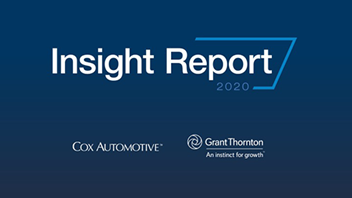- Third annual Cox Automotive and Grant Thornton Automotive Insight Report available from 18 November 2020
- Report features revised 2020 forecast, as well as projections for 2021 and beyond across new and used for both car and van
- Research highlights paradigm shifts and opportunities across electric vehicles, the subscription economy, digital retail and connected technology
The UK is on track for 1.57m new car registrations in 2020 and 2.02m in 2021, slightly ahead of the revised SMMT figures, according to the third annual Cox Automotive and Grant Thornton Automotive Insight Report, launched today (18 November 2020). The forecasts have been informed by analysis of market response after the financial crash in 2007/8, as well as nuanced considerations of Brexit, COVID-19, and global vehicle supply issues. The 2021 projection represents a -12.8% decline on the 2001-2019 average.
 Research conducted for the Insight Report, prior to the announcement of the second national lockdown in England, found just over half of dealers (52%) expected new car registrations to decline in 2021. Two fifths (42%) anticipated a further decline in consumer confidence. A third (33%) believed new car supply would increase in 2021, while just over a quarter (27%) felt the opposite. Demand has been influenced by COVID-19 trends, with Department for Transport data suggesting consumers have shifted from public to private transport.
Research conducted for the Insight Report, prior to the announcement of the second national lockdown in England, found just over half of dealers (52%) expected new car registrations to decline in 2021. Two fifths (42%) anticipated a further decline in consumer confidence. A third (33%) believed new car supply would increase in 2021, while just over a quarter (27%) felt the opposite. Demand has been influenced by COVID-19 trends, with Department for Transport data suggesting consumers have shifted from public to private transport.
The Insights team has also forecast the used car market, projecting 6.41m transactions by the end of 2020. With a shortfall of more than one million transactions against initial forecasts, it is clear that 2020 represents a fundamental shift to the market. However, it had already been in decline since the height of 8.1m transactions in 2017, and the 7.4m average across 2001-2019. For 2021, Cox Automotive and Grant Thornton UK LLP expect to see 6.66m transactions.
Two-thirds of dealers (64%) surveyed for this report, prior to news of the second national lockdown, expected used car transactions to increase in 2021, as compared with 2020. Almost a third (30%) expected values to increase in 2021. In terms of supply, respondents also identified the effect of fleet companies running their fleets for longer and de-fleeting less frequently, a trend which is already having an impact.
Philip Nothard, Insight and Strategy Director at Cox Automotive, comments: “While the COVID-19 pandemic has been – and continues to be – a significant challenge for the automotive sector, the idea that we have experienced anything ‘normal’ for the past 15 or even 20 years is a falsehood. The reality is there has very rarely been a long period of stability.
“If we are suggesting there is no such thing as normal, the other key factor that remains true is that consumer behaviour is underpinning industry paradigm shifts. Whether we talk about digital transformation, electrification, connectivity or, indeed, responding to the short-term market shocks, the driving force for industry change is consumer behaviour.”
The report also contains a section on business strategy development for 2021 and beyond. Owen Edwards, Associate Director, Grant Thornton UK LLP, adds: “The global automotive industry is rapidly adjusting to changes triggered by numerous sources: COVID-19; political and economic shifts; changes in emissions legislation; pressure from shareholders to generate more value; and increased consumer demand.
“Reducing cost will be a priority for many business leaders – in the short and the long term – and this will create an ongoing conflict between costs and the need to make profits. Continued consolidation is expected across the whole automotive industry to achieve economies of scale by building increasingly large companies, or operational efficiency to become more vertically integrated.”
Alongside the forecasts for the new and used car markets for the rest of 2020 and beyond, this year’s Cox Automotive and Grant Thornton Automotive Insight Report also looks at the subscription economy and Big Data, electric vehicles and the digital retail landscape, as well as providing information on integrated supply chains and end-to-end vehicle management.
To view the interactive report, click here
